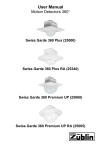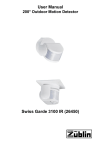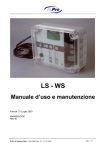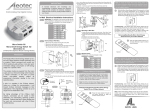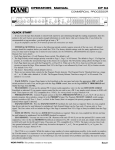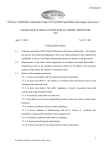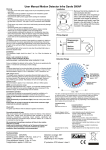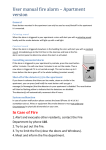Download User Manual Swiss Garde 290 IR (25250)
Transcript
User Manual Surface Mount Corner Motion Detector Swiss Garde 290 IR (25250) Warning! - Any work on the main power supply must only be completed by trained specialists. - The product must be installed in accordance with installation guidelines/standards specific to your country. - Disconnect the 230V power supply before starting the installation process. - As a precautionary measure, the power supply of the light should always be fitted with a (250VAC, 10A) type C fuse in accordance with EN60898-1. - Faulty lamps may cause a short-circuit and thereby permanently damage the device. - Disconnect power prior to replacing a lamp. - To ensure the operational reliability of the detector, keep a minimal distance of 1m to lamps installed on the same height level. - Lamps installed underneath the detector or in the detection area may disturb the functionality. Keep the detector away from heating devices. - In case of malfunction, such as continuous lighting, or false triggering please refer to the troubleshooting section on page 7. Function The detector reacts to the motion of heat (positive or negative in relation to the environment). If a person approaches the monitored area, the device will turn on the connected light automatically. If the person leaves the area, the light will be switched off after the preset duration (short impulse, 10 sec. to 20 min.). The connected light will be turned on only when the ambient light value is below the adjusted value. Installation The optimal installation height is about 2 to 3 m. Lead the cables through the mounting socket and screw the mounting socket tight. Ensure that no water intrusion along the cable is possible. Wire the detector as follows: phase / outer conductor (L); neutral-/ neutral conductor (N); switching output / switched phase/ outer conductor (L’) Slide the detector onto the socket and fix it. The potentiometer blind can be removed by turning anti-clockwise. The device is operational after approx. 1 minute from connecting to mains voltage. After this duration the detector can be programmed either by P-IR remote control (*) or by manipulating potentiometers. * The programming mode needs to be activated by remote control. Potentiometer adjustments will only be accepted during a stable working state 2 Connecting electrical loads High inrush currents will considerably shorten the lifetime of the detector’s in-built relay. Please verify the technical data provided by the lamp or luminaires manufacturer concerning inrush currents, specifically with compact fluorescent, fluorescent lamps, electronic ballast, etc. in order not to overload the internal relay. We recommend connecting a maximum of three to four motion detectors in parallel. If the number of switching cycles is above average or in the event of increased (inductive) loads, we recommend using the short pulse function on the motion detector and switching the load via an external staircase timer switch or contactor. Wiring diagrams Standard installation Several devices in parallel in short impulse mode (max. 3 to 4 devices) connected to a staircase timer switch. Detectors connected in parallel, with additional wall switch to enable permanent lighting. 3 Installation of an RC element, (between neutral conductor (N) and switched phase L‘) in case of interferences by fluorescent lamps (switch-off sparks) or by several detectors connected in parallel (caused by capacitive current in the wires). Varistor (between neutral conductor (N) und phase (L)) to reduce mains voltage peaks. Accessory: 3-button remote control Functions: Auto = automatic operation (default) ON = lights permanently ON * OFF = lights permanently OFF * * 6 hours duration, after which the detector will go be back to automatic mode. ON cannot be activated in short impulse mode! 4 Potentiometer controls overview Red LED, flashing once upon detection, three times upon adjusting TIME or LUX, or receiving a command from the remote control. Accessory: P-IR remote control For functions please refer to separate remote control manual. Attention! Manipulating LUX or TIME VR during a stable working condition, values will be stored and become valid. Any values adjusted by remote control will be overridden. Either manual values or values by remote control may be active, mixing is not possible. METER / SENS (sensitivity/detection range) Detection range adjustment max = approx. 15 m radius (walking person). Should the detector be too sensitive (triggering without movement in the detection range), the sensitivity/range can be reduced. TIME The timer determines for how long the lights will remain on following the last movement in the detection area. Choices are between short impulse (approx. 1 sec, approx. 20 sec. / 60 sec. break, selectable by remote control only) and time delay (approx. 10, 30 sec., 1, 2, 6, 10, 20 min.). Recommendation: approx. 2 min. in staircases, 10 min. in restrooms, etc. LUX (twilight sensor) The twilight sensor regulates the operating threshold (light value) of the detector determining when the device should be activated. Minimum value 5 lux (moon symbol): The detector will turn on the light at night. Maximum value 2000 lux (sun symbol): The detector will turn on the light during daytime as well. Recommendation: approx. 5 lux in staircases, 200 lux in office spaces. 5 Detection range The 290° (200°) omnidirectional detection zone and the dense detection field guarantee an optimal function. The range depends on the installation height and walking direction (high sensitivity when cutting or changing a switching segment). Since the detector reacts to temperature differences between heat source and ambient temperature, the response may vary depending on the installation site (floor heating, hot environment, etc.). top view frontal detection NOT SENSITIVE detection range = approx. -50% tangential detection = SENSITIVE side view 6 Troubleshooting error light does not turn on: cause/amendment - twilight adjustment value too low - connected lamp defective - check mains power / fuses detector triggers without light never turns off: - check detection area for potential reason / causes of false triggering: draught, animals, heating, etc. may all provoke faulty switching! - detector is too sensitive, reduce the detection range sensitivity (by remote control or VR) or cover disturbing segments on the lens by adhesive tape. - check distances to lamps (heat reflection or direct light influence) - connect RC element in parallel to transformers, relais, electric ballast light flashes periodically / detector doesn’t reach proper working condition - non-compensated fluorescent lamps need an RC element or compensation condenser installed. triggers or blocks at mains voltage peaks: - install a Varistor between phase (L) and neutral (N) wires light turns off even if motion is detected - increase the TIME value (to maximum if needed). turns the light on during daytime - twilight adjustment set too high (set to a lower value). Respect 1 min. start-up! - detector is installed in the shade - consider changing the location of detector After mains connection: the detector takes approx. 1 min. to reach a stable working condition! 7 Technical data Nominal power: Switching power: 230V / 50Hz 2300W / 10A max. (cos φ = 1) 1150VA / 5A max. inductive (cos φ = 0,5) short impulse approx. 1 sec. (20/60 sec. break) approx. 10 sec. to 20 min. 5 to 2000 lux or lux memory (via remote ctrl) AUTO / ON / OFF (4 to 6 m range) wall or corner mount 290° / 200° 2.5 m = max. 12 m radius 3.0 m = max. 13 m radius 3.5 m = max. 14 m radius 4.0 m = max. 15 m radius Time adjustment: Twilight switch: IR remote control: Detection range: (at inst. height): Rec. install. height: Environmental temperature: Dimensions (HxWxD): IP protection: 2 to 4 m -20 to +40 °C 130 x 116 (+40) x 80 mm IP44, class II Electronic Control Induction in long installation wires (if several detectors connected in parallel) may generate a considerable capacitive current on the switched phase. For electric loads using only a small control current, such as staircase timer switches, this may lead to permanent switching or general malfunctions. In order to minimise the capacitive current, an RC element may be connected in parallel to the load. Alternatively, a contactor, which is more tolerant to capacitive currents, may be installed before the load. We recommend a maximum of four detectors connected in parallel. Do not dispose of electrical appliances in your waste bin, use the collecting point of your municipality, or return the old device to your dealer. 8








